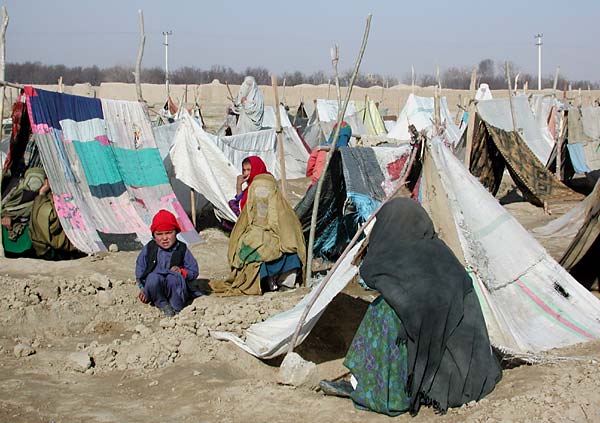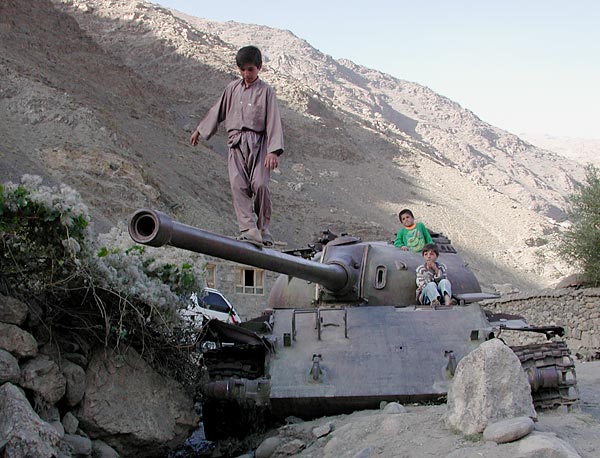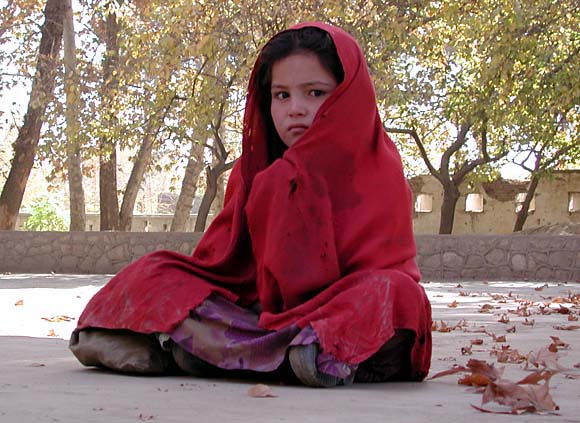Afghanistan’s civil war has displaced millions and created a whole class of impoverished people.
A visitor to Afghanistan is particularly struck by the haunting presence of destitute kids whose future is not simply dim, but, more likely, altogether dubious.
As the war raged, we encountered refugees around Kabul and the Panjsher Valley, Kunduz and Mazar-e-Sharif. And it was always the children who broke our hearts. The girl in red in the picture above lives in Taloqan, Takhar Province. Every Friday, she would sit on the pavement near the city’s main mosque to wait for alms, which devout Muslims are supposed to give to the poor after their prayers. Most of the Muslim men, however, were very poor themselves and the small change this girl and other beggars received was often too little.
This family stopped to warm themselves near a fire on the road from Kunduz to Taloqan at the height of American bombing raids against Taliban targets in Kunduz in November 2001. That was the time when hundreds of people were seen leaving the city every day, moving on trucks, donkeys, bicycles, and on foot.
Numerous shanty towns sprang up all over Afghanistan, each housing hundreds of people who had fled fighting or the collapse of local economies.
The see-through tents did not provide any warmth, even with a constantly burning fire inside, so in winter time the refugees had to seek shelter in mosques or sheds in nearby villages and towns.
But there is also another story behind the story.
When international relief organizations came to provide food aid, many Afghans set up phoney refugee camps close to their home villages to qualify for assistance. Men would be working in the fields, while women and children would sit in such camps all day long so that a sudden visit by the Red Cross or other international groups would not find their tent city deserted, which would put an end to the flow of food parcels. Representatives of the World Food Organization, one of the major food donors operating in Afghanistan, privately acknowledged the problem existed, but they preferred to turn a blind eye to this kind of cheating: people were forced to lie about their status because of the dire poverty into which they had been drawn by the exhausting war. In addition to that, many “genuine” refugees or, more correctly, internally displaced persons, did not hurry back to their home towns or villages after they were liberated from the Taliban. Their homes had been destroyed and local economies ruined, so thousands of Afghans came to rely on international aid for survival.
Needless to say that foreign reporters, too, “forgot” all these details and put the strict requirements of investigative journalism on hold, when it came to cover the dismal conditions in which the local inhabitants would most likely live for many years to come.
Several hundred refugees, who made up the population of the camp, dug holes in the earth and lived down there like rabbits or foxes, some for as long as five years by the time we visited them in February 2002. I am still impressed with the endurance of these people, and of people in general to this effect. The refugees were friendly and eager to talk about their life problems often in the naive belief that reporters and, especially, television journalists, would tell the world – and international relief organizations – that they did need help.
And they were right because it was thanks to journalists that the world public and, in many cases, aid agencies learned about their plight and extended a helping hand. In one remote area of Northern Afghanistan an impoverished farmer and a bunch of hungry kids were encouraged by television reporters to eat grass off the field to show how desperately they needed food aid, according to a translator who accompanied the filming crew. The story caused a furor in the West, and a food relief agency expedited wheat flour deliveries into the region, but privately, aid workers expressed indignation over the way the story was reported.
Among the “cave people” in the Mazar-e-Sharif area we met engineers, teachers, and pre-Taliban government officials who had fled into Northern Afghanistan. Mortality was high. One family arrived at the camp with two children, but after one year, their two-year old died of starvation and cold. And such stories galore.
I was rather skeptical about the future of all these internally displaced persons, living in camps scattered all over Afghanistan, that we visited in line of our journalistic duties. But when I recall a trip to one of several tent settlements in the Panjsher Valley I think there is still hope. And I did see that gleam of hope in the eyes of schoolchildren at the Anoba IDP camp at the height of the Northern Alliance’s offensive against the Taliban. The camp manager, Dr. Mohammad Tareq, set up a school with separate classes for boys and girls in keeping with Islamic tradition. The camp’s inhabitants did not have enough food, clothing, or even medicines, but they had a school where children were able to learn to read and write. “Knowledge is more important than food and clothes,” Dr. Tareq said. It was hard to accept this assertion in a country completely ruined by the war. But his belief was so inspiring that I even envied him for having this vision.











